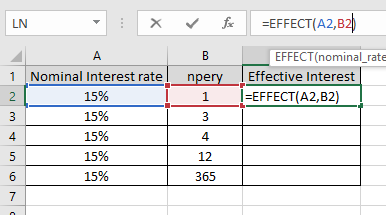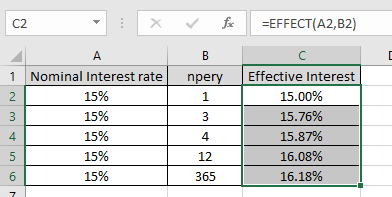In this article, we will learn about how to use the EFFECT function in Excel.
There are two forms of Interest rate
The relation between the two is shown below.

Here Npery is number of compounding periods per year
The EFFECT function returns the effective interest rate taking into account the compounding period. It takes nominal_rate & compounding period as arguments.
Syntax:
nominal rate : argument in as percentage or in decimals.
npery : number of compounding period per year
Let’s understand this function using it in an example.
Here we have some Nominal Interest rate values with different compounding periods per year.

Use the formula to calculate the Effective Interest rate
A2 : Nominal_rate
B2 : compounding period per year

Arguments to the formula are taken as cell references.
Change the cell format to percentage.

As you can see the required effective Interest rate is in percentage format.
Now copy the formula to other cells using Ctrl + D shortcut key.

This is how compounding period changes the Effective Interest rate.
Notes:
Hope you understood how to use EFFECT function and referring cell in Excel. Explore more articles on Excel function here. Please feel free to state your query or feedback for the above article.
Related Articles:
How to Use RATE Function in Excel
How to use the Excel XIRR function
How to Use IRR function in Excel
How to Use NPV function in Excel
Popular Articles:
50 Excel Shortcuts to Increase Your Productivity
How to use the VLOOKUP Function in Excel
The applications/code on this site are distributed as is and without warranties or liability. In no event shall the owner of the copyrights, or the authors of the applications/code be liable for any loss of profit, any problems or any damage resulting from the use or evaluation of the applications/code.